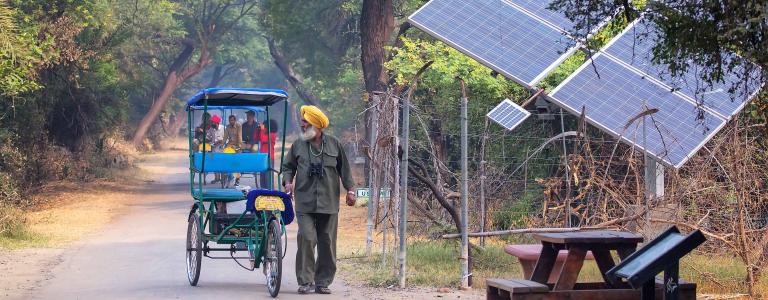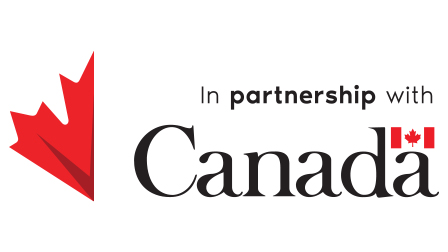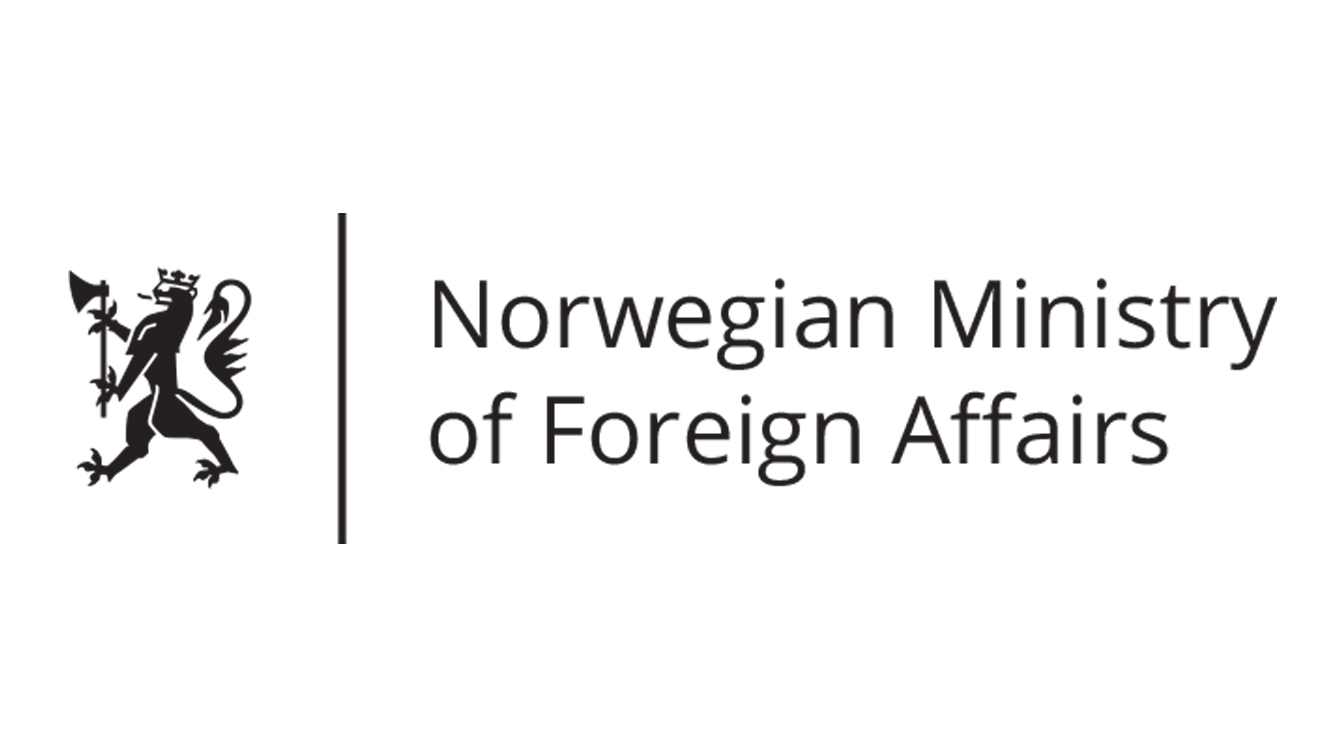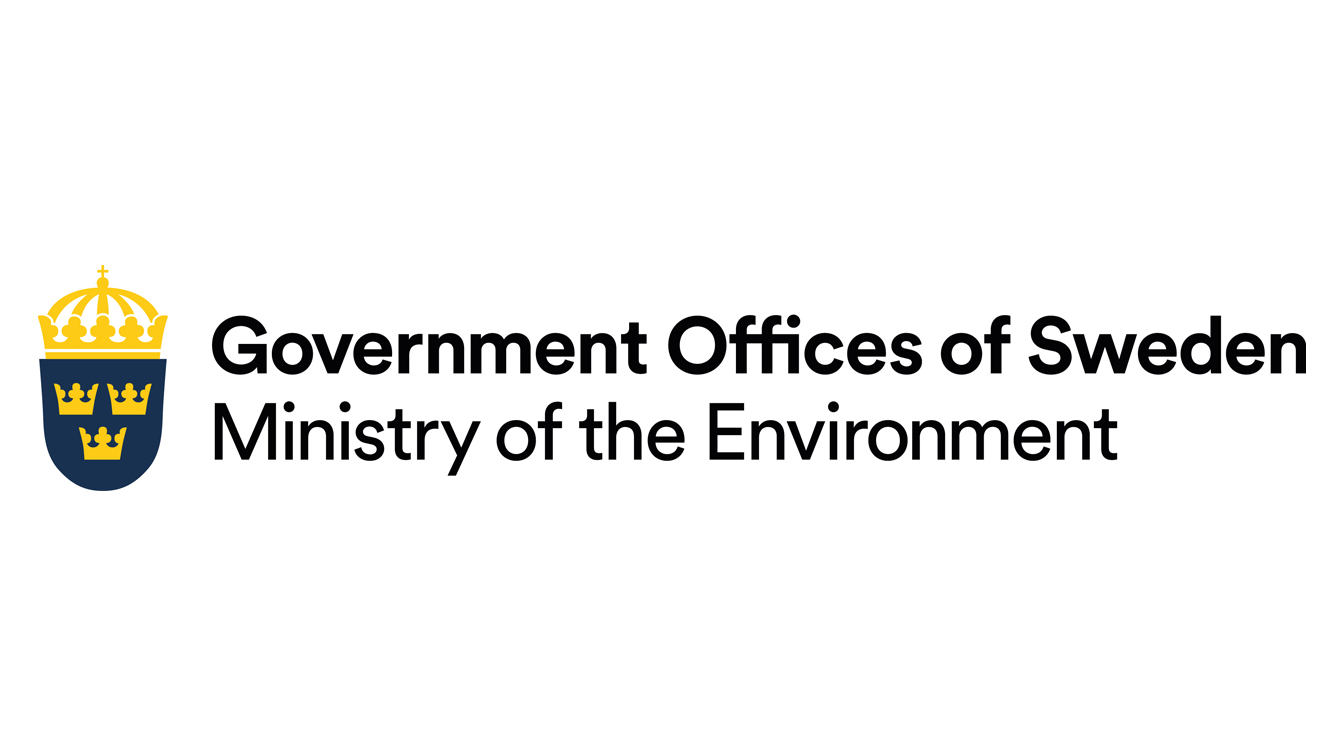The Global Governance of Sustainable Energy: Access and Sustainable Transitions
Still Only One Earth: Lessons from 50 years of UN sustainable development policy
No single organization owns the global sustainable energy transition. Its many facets and competing interests have led to a polycentric, non-hierarchical governance model—an approach with many positive features worth imitating as we tackle other environmental crises. (Download PDF) (See all policy briefs) (Subscribe to ENB)
Energy is both an enabler and a challenge for sustainable development. It powers our economies, fuels agriculture to feed billions of families, runs desalination plants in water- scarce countries, and keeps our homes cool or warm. Energy is fundamental for human development: it extends the hours people can work, how long a student can read a book, and what devices doctors can use in their hospitals.
In 1972, the Stockholm Conference on the Human Environment recognized energy production and use had harmful effects on the environment, and effective management required better understanding of these impacts. Five decades later, we know limiting global warming to safe levels requires leaving at least two-thirds of fossil fuel reserves unburned. Even so, renewable energy only accounts for 17% of global energy consumption. And close to 800 million people still lack access to electricity (IEA et al., 2020).
This is a reality check. We need to look to the future. We’re beginning to talk about energy in a much smarter way; energy is the story behind people’s lives. Without energy, that life story is not possible.
Thus, to achieve sustainable development, there are two major energy challenges: energy poverty and climate change. More than 3 billion people still lack access to clean cookstoves, relying on dirty fuels such as charcoal and wood. The indoor air pollution from burning these fuels kills an estimated four million people each year. On climate change, major efforts are needed to unlock the full potential of renewable energy and energy efficiency to deliver the carbon dioxide emission reductions necessary to meet the goals of the Paris Agreement (IRENA 2020). In 2015, the UN adopted the 2030 Agenda for Sustainable Development and its 17 Sustainable Development Goals (SDGs). SDG 7—affordable and clean energy—responded to these energy challenges in its targets.
To achieve SDG 7, governments and other stakeholders must form partnerships and coordinate significant transfers of technology and financing, especially to support the most vulnerable. Global energy agencies estimate that achieving SDG 7 by 2030 requires additional annual investments of USD 1.36 trillion. In 2017, however, international finance to support clean energy in developing countries only totaled USD 21 billion (IEA et al., 2020).
Primary indicators of global progress toward SDG 7 targets
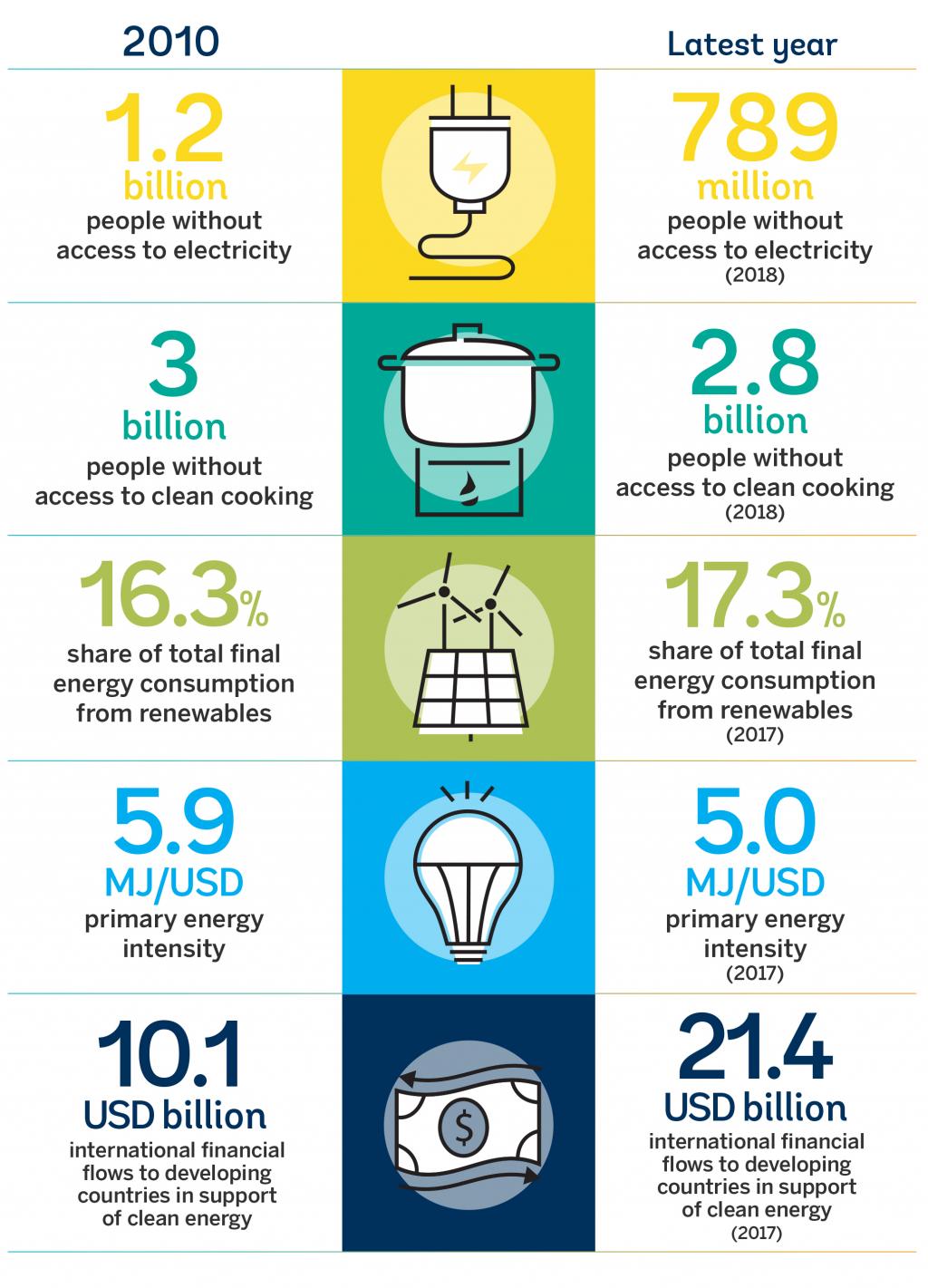
Multilateral governance of energy remains scarce and fragmented. The UN does not have a dedicated agency that covers all areas of energy policy. Even the term “global energy governance” is relatively new, as the agenda was long dominated by questions of energy security and related geopolitical competition.
The governance of sustainable energy is similarly fragmented. However, there have been some breakthroughs, including the establishment of the UN Sustainable Energy for All (SEforALL) initiative, the SDGs, and the International Renewable Energy Agency (IRENA).
Targets of SDG 7: Ensure access to affordable, reliable, sustainable and modern energy for all
- 7.1: By 2030, ensure universal access to affordable, reliable and modern energy services
- 7.2: By 2030, increase substantially the share of renewable energy in the global energy mix
- 7.3: By 2030, double the global rate of improvement in energy efficiency
- 7.a: By 2030, enhance international cooperation to facilitate access to clean energy research and technology, including renewable energy, energy efficiency and advanced and cleaner fossil-fuel technology, and promote investment in energy infrastructure and clean energy technology
- 7.b: By 2030, expand infrastructure and upgrade technology for supplying modern and sustainable energy services for all in developing countries, in particular least developed countries, small island developing States, and land-locked developing countries, in accordance with their respective programmes of support
Emergence of Sustainable Energy on the Global Agenda
The 1972 Stockholm Action Plan was the first major UN action plan to specifically draw attention to the relationship between energy and the environment. Through the years, various global conferences and reports highlighted the need to increase the share of renewable energy in the global energy mix and provide related support to developing countries. Launching the Third UN Development Decade in 1980, the UN General Assembly stressed: “The international community will have to make substantial and rapid progress in the transition from the present international economy based primarily on hydrocarbons.” Similar calls were made by the first World Climate Conference (1979), the UN Conference on New and Renewable Sources of Energy (1981), and the Brundtland Commission’s report, Our Common Future (1987).
A safe, environmentally sound, and economically viable energy pathway that will sustain human progress into the distant future is clearly imperative.
However, “no practical results on a global level [were] achieved from these recommendations,” as observed by German parliamentarian Hermann Scheer (EUROSOLAR and WCRE, 2009, 11). The 1992 action plan adopted at the Rio Earth Summit, Agenda 21, contained well over a hundred references to energy, but did not mandate new institutional arrangements in this area. The idea promoted by Scheer—an international solar energy agency—would take two decades to materialize.
The 2002 World Summit on Sustainable Development delivered the Johannesburg Plan of Implementation, which recognized that access to modern energy services was crucial for achieving the Millennium Development Goals (MDGs), which the UN had launched to meet the needs of the world’s poorest by 2015. It also called for integrating energy considerations into national development strategies. Some of the multi-stakeholder Partnerships for Sustainable Development established in Johannesburg also focused on providing energy access to support the MDGs.
UN-Energy was established in 2004 to ensure follow up on the various energy-related decisions from Johannesburg. UN-Energy, however, is an inter-agency mechanism with the mandate to focus primarily on coordinating the energy-related work of 20 UN organizations. UN-Energy also sought to support countries in delivering both on the MDGs and the climate agenda (UNIDO, 2020).
One of the challenges in making progress on sustainable energy was a lack of agreement among governments. Many developing countries insisted energy access should be the priority, and the choice of technology should be secondary. Many fossil fuel producers did not want to damage their economies by promoting a shift away from fossil fuels. Others, including small island developing states (SIDS), were concerned about climate change and pressed for an emphasis on renewable energy and emission reductions (Kamau et al., 2018). Yet there was a need for stronger international institutional arrangements to help countries and their people gain access to electricity and make the transition to sustainable energy.
International Renewable Energy Agency
Developing countries proposed creating a UN agency to support solar energy in the early 1980s, but some industrialized countries, including the US and Japan, opposed this idea. Some suggest the motive of these leading renewable energy technology developers was to prevent industrial competition from emerging in developing countries, which were important future markets. None of the existing global energy institutions actively promoted renewables at the time, and many underscored the need to pool resources to support related research and development, technology transfer, and capacity building in developing countries (EUROSOLAR and WCRE, 2009).
After much lobbying and with interest in renewable energy increasing worldwide, Germany convened a preparatory process in 2008, which resulted in the founding of IRENA a year later. Following a highly competitive campaign, the United Arab Emirates, which had pitched itself as a bridge between conventional and future energy and East and West, was selected as the seat of the agency’s headquarters.
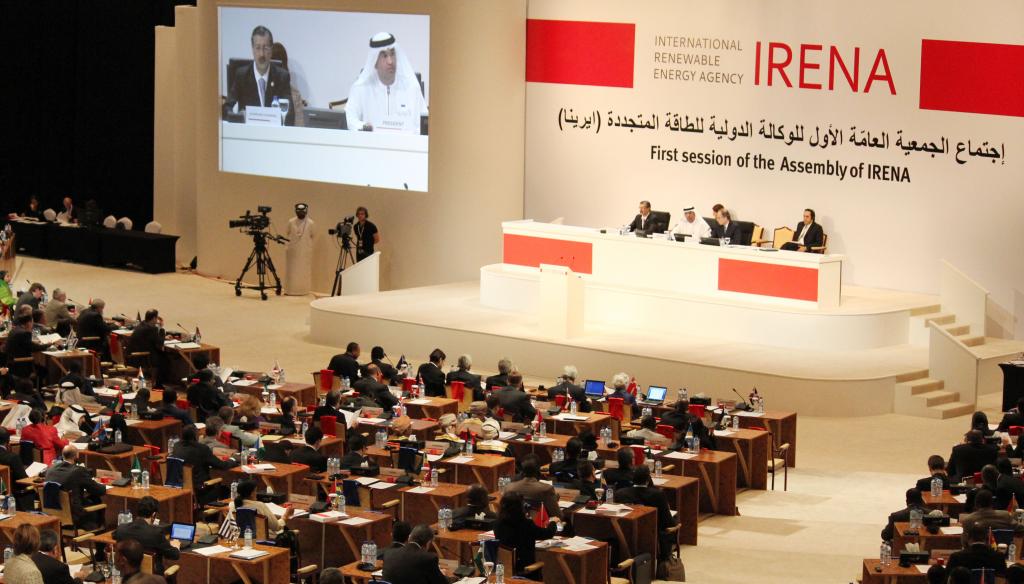
IRENA, which has 161 Member States, is governed by an Assembly that meets annually to decide on the agency’s programme and budget, supported by a Council with a rotating membership. The agency conducts research, provides mapping, planning and policy tools and advice, and leads multi- stakeholder initiatives, most prominently three regional Clean Energy Corridors, the SIDS Lighthouses Initiative, and the Global Geothermal Alliance. IRENA itself does not provide financing, but the affiliated IRENA/ Abu Dhabi Fund for Development Project Facility offers small-scale co-financing loans.
By focusing on the regional level in areas such as grid infrastructure and electricity markets, energy resource diversification, and investment promotion and job creation, the Clean Energy Corridors play a crucial role in ratcheting up political support for renewables, supporting coordinated energy planning, building business cases for renewables, and helping to create enabling environments for investments. Taking an approach that seeks to cater to country-specific needs and priorities of multiple stakeholders, the Africa Clean Energy Corridor has helped identify high- potential renewable energy generation zones and related investment options, conducted regulatory readiness assessments, and provided technical assistance. The small-scale loans, in turn, have enabled developing countries to expand energy access and reduce dependence on fossil fuel imports.
Sustainable Energy for All
The same year IRENA was founded, UN Secretary-General Ban Ki-moon established a high-level, multi-stakeholder Advisory Group on Energy and Climate Change. The group identified two priority areas for enhanced effort and international cooperation and called for a global campaign to support them: access (ensuring universal access to modern energy services by 2030) and efficiency (reducing global energy intensity by 40% by 2030) (AGECC, 2010).
In response, the UN General Assembly, in resolution 65/151, declared 2012 as the International Year of Sustainable Energy for All and, in resolution 67/215, declared 2014– 2024 the Decade of Sustainable Energy for All. The Secretary-General then launched the SEforALL initiative to mobilize action from all sectors of society to realize sustainable energy for all by 2030.
Energy is the golden thread that connects economic growth, increased social equity and a healthy environment. Sustainable development is not possible without sustainable energy.
SEforALL is a unique international organization. Its principal governing body, the Administrative Board, is comprised of leaders from governments, industry, and foundations. SEforALL’s flagship efforts have included the multi-agency Global Tracking Framework, which produces an annual progress report on SDG 7, and an annual forum, which takes stock of progress, seeks to mobilize financing, and provides a platform for promoting collaboration and showcasing action. The initiative also has various programmes that seek to engage businesses, governments, consumers, and NGOs in areas including clean cooking, energy finance, policy and regulation, health sector electrification, and female energy leaders. SEforALL relies on Regional and Thematic Hubs and Accelerators to reach countries and coordinate multi- stakeholder partnerships. These include the Energy Efficiency Hub, hosted at the Copenhagen Centre on Energy Efficiency, and the Renewable Energy Hub, hosted by IRENA.
SEforALL’s achievements are underpinned by its multi-stakeholder approach to cooperation: its data partnership, the Knowledge Hub, tracks progress on SDG 7. Its Regional Hubs, which bring together development banks, UN agencies, regional organizations, and country focal points, have helped deliver dozens of action agendas and investment prospectuses that lay out nationally tailored approaches to achieving SDG 7. Its Global Energy Efficiency Accelerator platform supports public-private partnerships and drives action and commitments by national and sub- national leaders in energy efficiency sectors, including appliances, buildings, district heating or cooling, and vehicle efficiency (SEforALL, 2016).
Enter the SDGs
The MDGs did not include an energy- specific goal. Some attributed this to a long- standing disagreement between the Global South and North on whether energy was primarily a “social and economic good” or an “environmental bad.” SEforALL intentionally aimed to refocus the debate by emphasizing both the role of energy in sustainable development and the importance of protecting the environment (McDade, 2013), and its three targets adopted in 2011 influenced the negotiations on SDG 7.
This difference in views was reflected in the SDG negotiations, with many developing countries insisting energy access should be the priority, and the choice of technology would be secondary. Similarly, some developed countries’ proposal for including a target to phase out inefficient fossil fuel subsidies was rejected by developing countries arguing that, in some cases, they were necessary for poverty reduction. This target was eventually included under SDG 12 on sustainable consumption and production (Kamau et al., 2018).
The SDGs are universal and achieving SDG 7 is a global task. Furthermore, since the SDGs were designed as an integrated agenda, sustainable development requires achieving all 17 goals. Along these lines, implementing SDG 7 enables progress on other goals, including SDG 13 (climate action) through promotion of renewables and energy efficiency. Expanding sustainable energy access can help bring people out of poverty (SDG 1), reduce hunger (SDG 2), promote good health and well-being (SDG 3), and provide clean water and sanitation (SDG 6), among others. In contrast, trade-offs can also occur, for example between SDGs 7 and 2 if energy crops drive up food prices, or between SDGs 7 and 8 (decent work and economic growth) if just transitions for fossil fuel sector workers are not ensured.
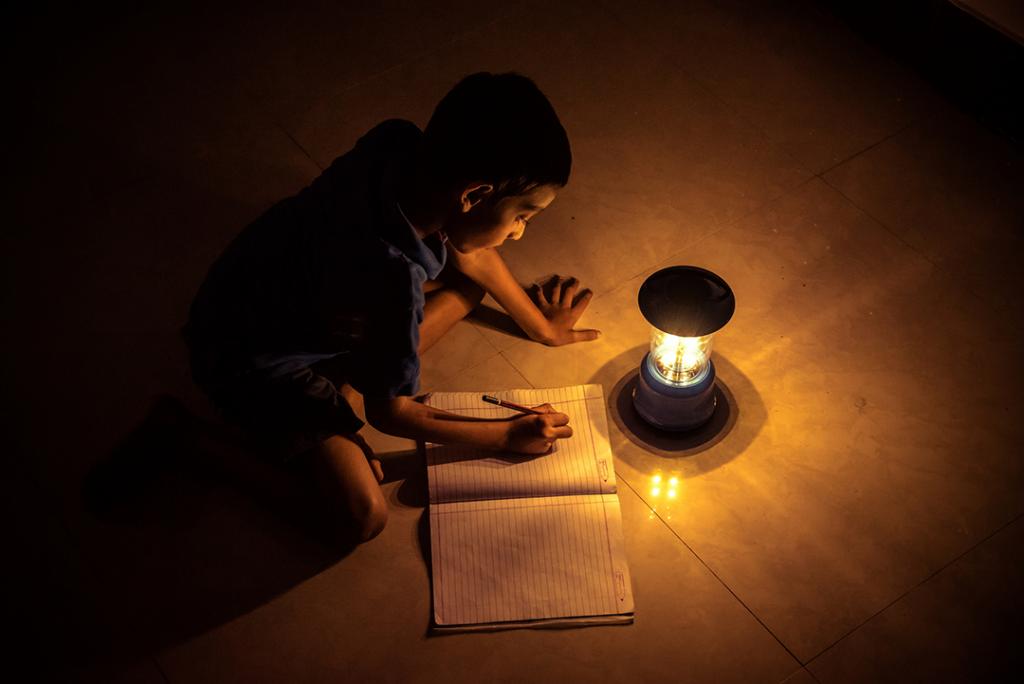
SDG 7’s three targets also interact with each other. Energy efficiency decreases the need to expand energy access and renewable energy capacity. The relationship between energy access and renewable energy is more complex. Distributed renewable energy can boost rural energy access, but it must be well designed— an infrastructure-heavy approach could raise energy prices and reduce accessibility. Increasing energy access could support scaling up of renewable energy, but this depends on the energy source—many developing countries continue to build fossil fuel-powered infrastructure (ICSU, 2017).
Beyond the SDGs, the 2015 Paris Agreement on climate change can also contribute to the achievement of SDG 7. The Paris Agreement introduced a vehicle for countries to periodically report their emission reduction targets and plans. To date, 186 countries have communicated nationally determined contributions (NDCs). Although their exact content is left for countries to decide, 140 countries have included renewables in the power sector in their first NDCs. Out of these, 105 countries’ NDCs include quantitative targets which, if implemented, would increase global installed renewable energy capacity by 87% over the next decade (IRENA, 2019).
The Regime Complex of Sustainable Energy Governance
Beyond SEforALL and IRENA, there are other organizations that participate in global governance of sustainable energy. Researchers have described this as a “regime complex,” which refers to an institutional landscape with overlapping mandates and an absence of a clear hierarchy (Van de Graaf and Colgan, 2015). Organizations, initiatives, and assemblies addressing sustainable energy include those under and outside the UN umbrella. Some are strictly intergovernmental while others include multiple stakeholders. Some have restricted membership while others function as “coalitions of the willing.”
Among the most prominent UN agencies, the UN Industrial Development Organization (UNIDO) is one of the organizers of the Vienna Energy Forum, which has met biennially since 2009 to discuss sustainable energy from a development perspective. The UN Environment Programme hosts the multi- stakeholder network REN21, established in 2005 and best known for its renewable energy status reports and International Renewable Energy Conferences. The World Bank supports SDG 7 through its Energy Sector Management Assistance Program partnership.
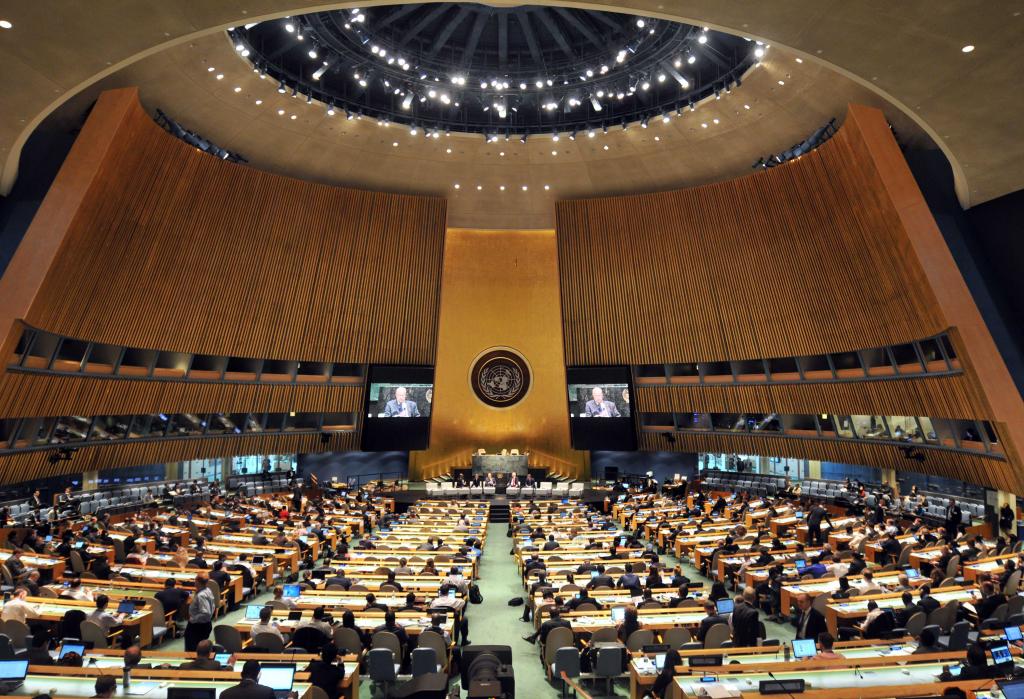
Other prominent institutions have also included sustainable energy on their agendas since the mid-2000s, prompted by rising oil prices and concerns about climate change. These include the Group of Seven and Group of Twenty (G20). The high-level Clean Energy Ministerial, initiated by the United States in 2010, brings together a group of G20 and non-G20 countries who collaborate to accelerate the deployment of clean energy technologies. The industrialized countries’ International Energy Agency (IEA) has long addressed sustainable energy. In 2019, it established an intergovernmental collaboration platform called the Energy Efficiency Hub, which encourages exchange and collaboration on key energy efficiency topics among its members and the wider international community.
These elements of the sustainable energy regime complex emphasize research and technology cooperation, knowledge sharing, capacity building, and fostering of multi- stakeholder partnerships. SDG 7 sets clear policy targets for this area of global governance, backed up by regular monitoring of progress through the UN High-level Political Forum on Sustainable Development, SEforALL, and the SDG 7 custodian agencies, including the IEA, IRENA, the UN Statistics Division, the World Bank, and the World Health Organization. However, the SDGs are not legally-binding, and there is currently no single international organization or treaty that can holistically promote the entire sustainable energy agenda.
In the long run, I think the UN needs an energy entity because that is the only way you can raise enough support for 15 or 20 years. It has to be an institution, however, that allows private sector involvement next to governmental initiative because we need its cash and knowledge.
Into the Decisive Decade
Less than a decade remains to implement SDG 7 and halve global greenhouse gas emissions in order to stay below 1.5°C of global warming and avoid the worst impacts on human life. Tracking reports prepared before the COVID-19 pandemic showed accelerated efforts were needed on all targets, with 620 million people projected to still lack electricity access in 2030 and a 50% increase in renewables deployment needed to stay below 2°C, let alone 1.5°C, of global warming. The pandemic may further negatively impact energy access and energy transitions, but its full impact remains to be seen (IEA et al., 2020; IRENA, 2019).
Global governance of sustainable energy has come a long way. Its current, polycentric regime can be viewed as a source of strength. As an early adopter of multi-stakeholder approaches, the sustainable energy sector provides positive examples and lessons for other areas of global governance. Its partnerships are highly specialized and action oriented. They often focus on solutions tailored to nation- or region-specific circumstances. The informality of many of these partnerships enables quicker action and helps create new coalitions that draw from the strengths and resources of non-state and sub-national actors. The SEforALL hubs and accelerators are an example in point.
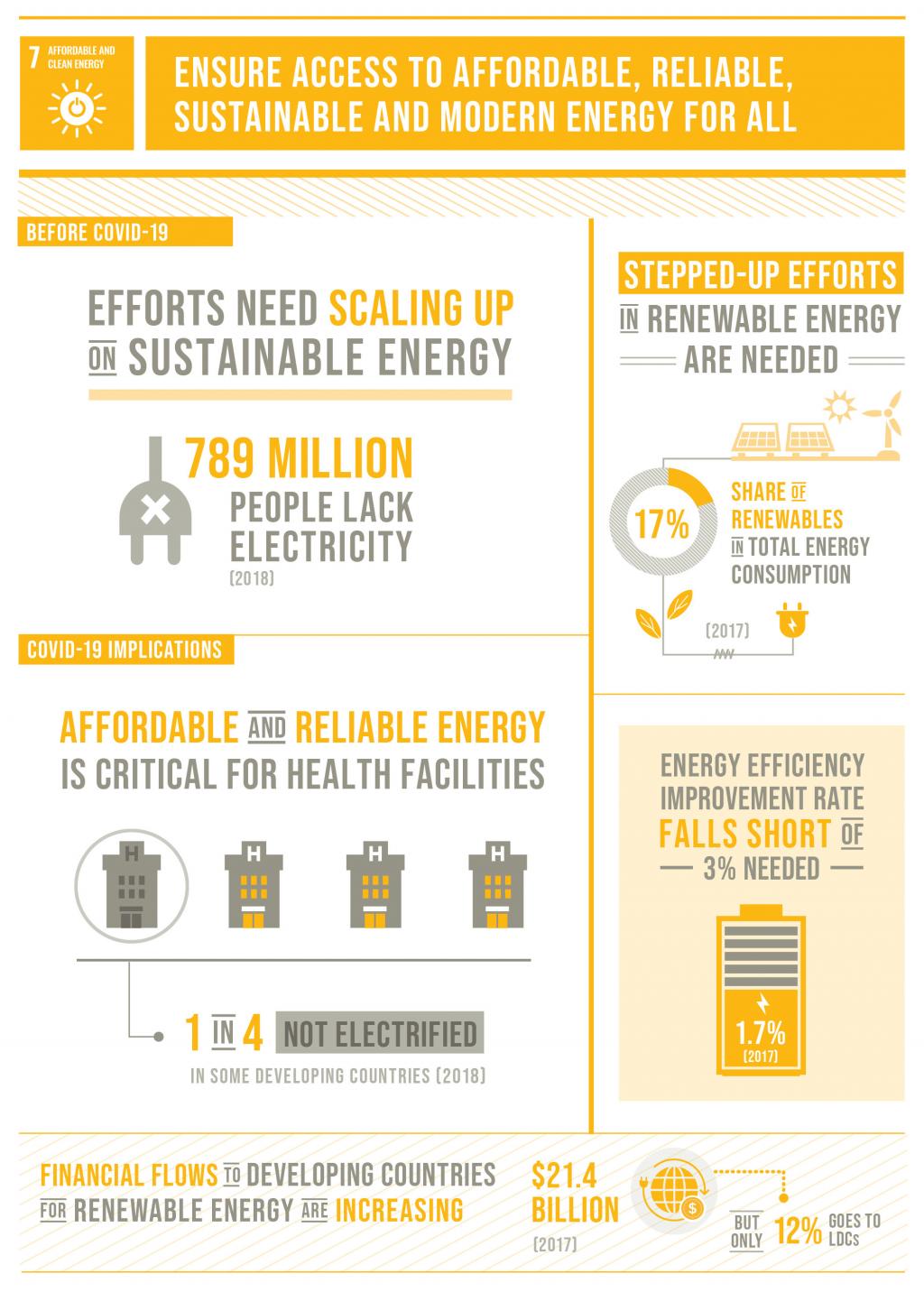
However, some factors have hindered and continue to limit the effectiveness of this model. The absence of a single international organization or treaty hampers the adoption of common rules and norms and cannot drive ambition from the top. This is partly a result of institutional path dependence: competition between oil exporters and importers as well as single-energy technology organizations have defined the field for a long time. Energy access and transitions, in turn, require global cooperation and crosscutting approaches. As sustainable energy gains a more prominent place on the global agenda, its government and private sector champions may push global energy governance to become more holistic and cooperative.
Another remaining challenge is that different countries still have different priorities attached to the sustainable energy agenda. In this regard, however, SDG 7 represents a rather successful attempt to merge the access and transition agendas into one. The strong synergies between its three targets and between SDG 7 and other SDGs bodes well for its success.
Works Consulted
AGECC. (2010). Energy for a Sustainable Future. United Nations. https://www.un.org/chinese/millenniumgoals/pdf/AGECCsummaryreport%5B1%5D.pdf
EUROSOLAR and WCRE. (2009). The long road to IRENA: From the idea to the foundation of the International Renewable Energy Agency. Documentation 1990–2009. Ponte Press.
ICSU (International Council for Science). (2017). A guide to SDG interactions: From science for implementation. ICSU.
IEA, et al. (2020). Tracking SDG 7:The energy progress report 2020. World Bank.
IRENA. (2019). NDCs in 2020: Advancing Renewables in the Power Sector and Beyond. IRENA.
IRENA. (2020). Global renewables outlook: Energy transformation 2020. IRENA.
Kamau, M., Chasek, P. & O’Connor, D. (2018). Transforming multilateral diplomacy: The inside story of the Sustainable Development Goals. Routledge.
McDade, S. (2013). SDG 7 and sustainable energy development in Latin America and the Caribbean. UN Chronicle, 9. https://doi.org/10.18356/cb2c5053-en
SEforALL. (2016). Sustainable Energy for All: Strategic framework for results 2016–21. SEforALL.
UNIDO. (2020). UN Energy. https://www.unido.org/our-focus/cross-cutting-services/green-industry/partnerships/un-energy
Van de Graaf, T. & Colgan, J. (2016). Global energy governance: A review and research agenda. Palgrave Communications, 2. https://doi.org/10.1057/palcomms.2015.47
You might also be interested in
Web of resilience
Pakistan's development model has still not recognised the limits of the natural environment and the damage it would cause, if violated, to the sustainability of development and to the health and well-being of its population. Pakistan’s environment journey began with Stockholm Declaration in 1972. A delegation led by Nusrat Bhutto represented the country at the Stockholm meeting, resulting in the establishment of the Urban Affairs Division (UAD), the precursor of today’s Ministry of Climate Change. In setting the country’s environmental agenda, we were inspired by the Stockholm Principles, but in reality, we have mostly ignored them for the last five decades.
Pathways to Sustainable Cities
Urban planning needs to be inclusive and responsive to the needs of local communities and build on participatory approaches that foster the engagement of marginalized actors.
A Warming Arctic is a Warning for the World
To protect the Arctic, stronger and broader local, national, and international measures to reduce greenhouse gas emissions must be implemented.
The Water and Sanitation Challenge
For universal access to water to become a reality, governments and private-sector service providers should adopt a human rights-based approach to ensure water and sanitation services are safe, available, accessible, affordable, and culturally acceptable.
